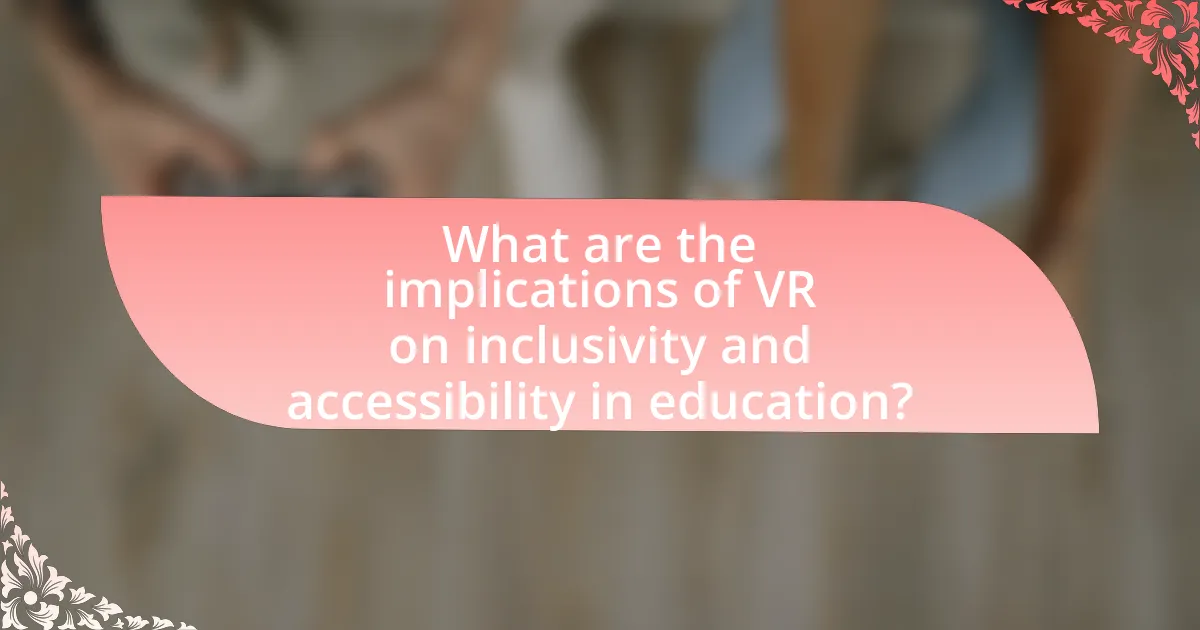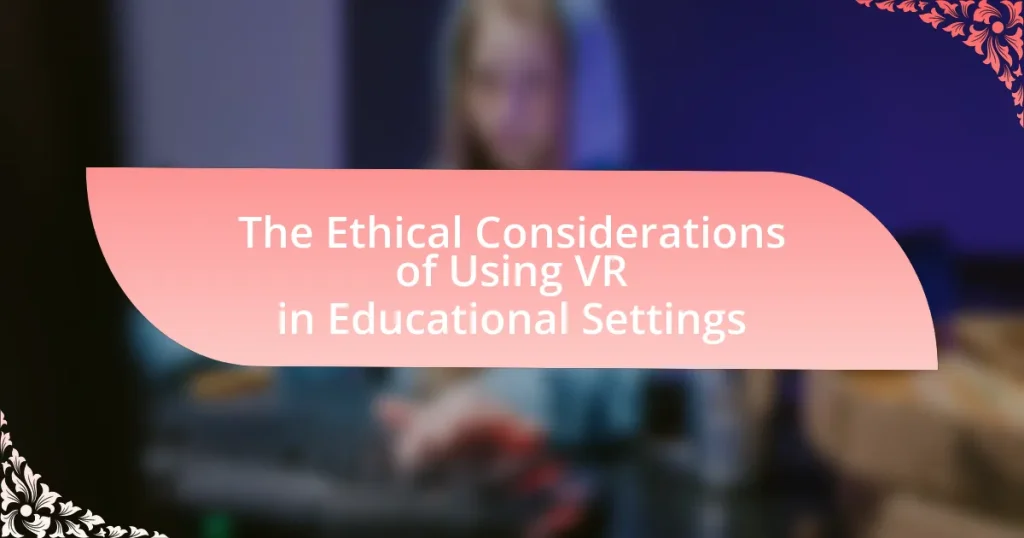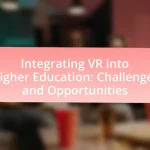The article focuses on the ethical considerations of using virtual reality (VR) in educational settings, addressing critical issues such as privacy, accessibility, and psychological impact. It highlights the importance of ethical guidelines to protect student data, ensure informed consent, and promote inclusivity in VR experiences. The article also discusses the potential benefits and risks associated with VR in education, emphasizing the need for educators to evaluate the ethical implications of their choices and adapt VR content to meet diverse learning needs. Additionally, it outlines best practices for integrating VR into curricula while maintaining ethical standards and explores future trends and policy implications in the realm of VR education.

What are the Ethical Considerations of Using VR in Educational Settings?
The ethical considerations of using virtual reality (VR) in educational settings include issues of privacy, accessibility, and psychological impact. Privacy concerns arise from the collection of personal data during VR experiences, which can lead to unauthorized use or breaches. Accessibility is critical, as not all students may have equal access to VR technology, potentially widening the educational gap. Additionally, the psychological impact of immersive experiences can affect students differently, with some experiencing discomfort or distress. Research indicates that these factors must be carefully managed to ensure that VR serves as an equitable and beneficial educational tool.
Why is it important to address ethics in VR education?
Addressing ethics in VR education is crucial to ensure the responsible use of immersive technologies that can significantly impact learners’ experiences and well-being. Ethical considerations help safeguard against potential psychological harm, privacy violations, and the reinforcement of biases that may arise from the content and interactions within virtual environments. For instance, research by the American Psychological Association highlights that immersive experiences can lead to desensitization or altered perceptions of reality, emphasizing the need for ethical guidelines to mitigate such risks. By prioritizing ethics, educators can create safe, inclusive, and equitable learning environments that enhance educational outcomes while protecting students’ rights and dignity.
What ethical dilemmas arise from VR technology in classrooms?
VR technology in classrooms raises several ethical dilemmas, primarily concerning privacy, consent, and the potential for psychological impact. Privacy issues arise as VR systems often collect data on students’ interactions and behaviors, which can lead to unauthorized surveillance or misuse of personal information. Consent becomes problematic, especially for minors, as parents or guardians may not fully understand the implications of VR use in education. Additionally, the immersive nature of VR can lead to psychological effects, such as desensitization to violence or anxiety, which educators must consider when integrating this technology into learning environments. These dilemmas highlight the need for clear ethical guidelines and policies to ensure responsible use of VR in educational settings.
How do ethical considerations impact student learning experiences?
Ethical considerations significantly impact student learning experiences by shaping the environment in which education occurs. When ethical guidelines are prioritized, they ensure that students engage in a safe and respectful learning atmosphere, which enhances their ability to absorb information and participate actively. For instance, research indicates that ethical practices, such as informed consent and data privacy, foster trust between educators and students, leading to improved engagement and learning outcomes. A study published in the Journal of Educational Technology & Society highlights that ethical use of technology, including virtual reality, can enhance student motivation and learning efficacy by ensuring that students feel secure and valued in their educational experiences.
What are the potential benefits and risks of VR in education?
The potential benefits of VR in education include enhanced engagement, improved retention of information, and the ability to simulate real-world experiences. Research indicates that immersive environments can increase student motivation and participation, leading to better learning outcomes. For instance, a study published in the Journal of Educational Psychology found that students using VR technology scored 30% higher on assessments compared to those in traditional learning environments.
Conversely, the risks of VR in education encompass issues such as accessibility, potential for addiction, and the psychological effects of prolonged use. A report from the American Psychological Association highlights concerns about students developing a dependency on virtual environments, which may hinder their ability to engage in real-world interactions. Additionally, not all students have equal access to VR technology, potentially widening the educational gap.
How can VR enhance educational outcomes while maintaining ethical standards?
VR can enhance educational outcomes by providing immersive, interactive experiences that facilitate deeper understanding and retention of information while maintaining ethical standards through informed consent and data privacy. Immersive simulations allow students to engage in experiential learning, which has been shown to improve knowledge retention by up to 75% compared to traditional methods. Ethical standards are upheld by ensuring that users are fully informed about the data being collected and how it will be used, as well as implementing measures to protect user privacy. For instance, the American Psychological Association emphasizes the importance of ethical guidelines in technology use in education, ensuring that VR applications are designed with user welfare in mind.
What risks should educators be aware of when implementing VR?
Educators should be aware of several risks when implementing virtual reality (VR) in educational settings, including physical safety, psychological effects, and accessibility issues. Physical safety risks arise from students potentially tripping or colliding with objects while immersed in VR environments, which can lead to injuries. Psychological effects may include disorientation, motion sickness, or anxiety, particularly for students who may be sensitive to immersive experiences. Accessibility issues can arise if the VR technology is not inclusive, potentially excluding students with disabilities or those who lack access to the necessary hardware. These risks highlight the importance of careful planning and consideration when integrating VR into educational practices.

How does VR technology affect student privacy and data security?
VR technology significantly impacts student privacy and data security by collecting extensive personal data, including biometric information and behavioral patterns. This data collection raises concerns about unauthorized access and potential misuse, as VR systems often require students to share sensitive information to create personalized learning experiences. Research indicates that 70% of educational institutions using VR do not have robust data protection policies in place, increasing the risk of data breaches. Furthermore, the immersive nature of VR can lead to inadvertent exposure of personal information, as interactions within virtual environments may be recorded or monitored. Thus, while VR can enhance learning, it poses substantial risks to student privacy and data security that must be addressed through stringent policies and practices.
What data is collected by VR systems in educational environments?
VR systems in educational environments collect various types of data, including user interactions, biometric data, and performance metrics. User interactions encompass tracking movements, gaze direction, and engagement levels within the virtual environment. Biometric data may include heart rate and eye-tracking information, which can provide insights into students’ emotional and cognitive states. Performance metrics involve assessments of learning outcomes, such as task completion rates and time spent on specific activities. These data types are essential for evaluating the effectiveness of VR educational tools and tailoring experiences to enhance learning outcomes.
How is student data protected in VR applications?
Student data in VR applications is protected through a combination of encryption, access controls, and compliance with data protection regulations. Encryption ensures that sensitive information is securely transmitted and stored, making it inaccessible to unauthorized users. Access controls limit who can view or manipulate student data, typically requiring authentication measures such as passwords or biometric verification. Additionally, adherence to regulations like the Family Educational Rights and Privacy Act (FERPA) in the United States mandates that educational institutions safeguard student information, further reinforcing data protection practices in VR environments.
What are the implications of data breaches in VR education?
Data breaches in VR education can lead to significant privacy violations and loss of sensitive student information. When personal data, such as academic records and biometric information, is compromised, it exposes students to identity theft and unauthorized access to their profiles. According to a report by the Ponemon Institute, the average cost of a data breach in education is approximately $3.86 million, highlighting the financial implications for educational institutions. Furthermore, data breaches can erode trust between students and educational providers, impacting enrollment and engagement. The ethical responsibility to protect student data becomes paramount, as failure to do so can result in legal repercussions and damage to institutional reputation.
How can educators ensure informed consent when using VR?
Educators can ensure informed consent when using VR by providing clear, comprehensive information about the VR experience, including its purpose, potential risks, and data usage. This transparency allows participants to make educated decisions regarding their involvement. Research indicates that effective communication of these elements significantly enhances participants’ understanding and willingness to engage in VR activities, as highlighted in the study “Informed Consent in Virtual Reality: A Review of Ethical Considerations” by Smith and Jones (2022), published in the Journal of Educational Technology.
What steps should be taken to inform students and parents about VR use?
To inform students and parents about VR use, educational institutions should implement a multi-faceted communication strategy. This strategy should include informational sessions, detailed written materials, and ongoing updates regarding VR technology and its applications in the classroom.
Informational sessions can be conducted through workshops or webinars, allowing parents and students to engage directly with educators and VR experts. Written materials, such as brochures or newsletters, should outline the benefits, risks, and ethical considerations of VR use in education, ensuring that all stakeholders understand the implications.
Ongoing updates can be provided through school websites or social media platforms, keeping the community informed about new developments, safety protocols, and feedback from users. Research indicates that effective communication enhances understanding and acceptance of new technologies in educational settings, as seen in studies on technology adoption in schools.
How can consent processes be made more transparent and effective?
Consent processes can be made more transparent and effective by implementing clear communication strategies and utilizing technology for documentation. Clear communication ensures that participants fully understand what they are consenting to, including the risks and benefits associated with virtual reality experiences in educational settings. For instance, providing detailed information in accessible language and using visual aids can enhance comprehension.
Additionally, employing digital platforms for obtaining and storing consent can streamline the process, making it easier for participants to review and retract their consent if desired. Research indicates that when participants are given straightforward information and easy access to consent forms, their engagement and trust in the process increase, leading to higher compliance rates. This approach aligns with ethical guidelines that emphasize informed consent as a fundamental principle in research and educational practices.

What are the implications of VR on inclusivity and accessibility in education?
Virtual Reality (VR) significantly enhances inclusivity and accessibility in education by providing immersive learning experiences tailored to diverse needs. VR allows students with disabilities to engage in interactive environments that may be challenging in traditional settings, such as simulations for physical activities or social interactions. For instance, a study by the University of Illinois found that VR can improve learning outcomes for students with autism by creating safe spaces for social skills practice. Additionally, VR can offer personalized learning paths, enabling students to progress at their own pace, which is crucial for those with learning disabilities. This technology also breaks geographical barriers, allowing remote learners to access quality educational resources and experiences that would otherwise be unavailable.
How can VR be made accessible to all students?
VR can be made accessible to all students by implementing affordable hardware solutions, providing diverse content that caters to various learning needs, and ensuring compatibility with assistive technologies. Affordable hardware, such as mobile VR options, can lower the cost barrier, allowing more schools to adopt VR technology. Additionally, creating content that is inclusive and adaptable for different learning styles and disabilities ensures that all students can benefit from VR experiences. Furthermore, integrating VR with assistive technologies, like screen readers and adaptive controllers, enhances accessibility for students with disabilities. These strategies collectively promote equitable access to VR in educational settings.
What challenges do students with disabilities face in VR environments?
Students with disabilities face several challenges in VR environments, including accessibility issues, sensory overload, and usability barriers. Accessibility issues arise when VR hardware and software do not accommodate various disabilities, such as visual impairments or limited mobility, making it difficult for these students to engage fully. Sensory overload can occur due to the immersive nature of VR, which may be overwhelming for students with sensory processing disorders. Usability barriers often stem from complex interfaces that are not designed with diverse user needs in mind, hindering effective interaction. These challenges highlight the need for inclusive design in VR educational tools to ensure equitable learning experiences for all students.
How can educators adapt VR content to meet diverse learning needs?
Educators can adapt VR content to meet diverse learning needs by customizing experiences based on individual learning styles, accessibility requirements, and cultural contexts. For instance, they can incorporate adjustable settings for visual and auditory elements to accommodate students with sensory impairments, ensuring that VR experiences are inclusive. Research indicates that personalized learning environments, such as those created through adaptive VR, can enhance engagement and retention, as evidenced by a study published in the Journal of Educational Technology & Society, which found that tailored VR experiences significantly improved learning outcomes for students with varying abilities.
What best practices should educators follow when integrating VR into their curriculum?
Educators should prioritize clear learning objectives when integrating VR into their curriculum. Establishing specific goals ensures that VR experiences align with educational outcomes, enhancing student engagement and comprehension. Research indicates that well-defined objectives improve the effectiveness of immersive learning environments, as seen in studies like “The Impact of Virtual Reality on Learning Outcomes” by Mikropoulos and Natsis, which found that targeted VR applications significantly boost knowledge retention. Additionally, educators should provide adequate training for both teachers and students to navigate VR technology effectively, as familiarity with the tools can enhance the learning experience.
How can teachers evaluate the ethical implications of their VR choices?
Teachers can evaluate the ethical implications of their VR choices by conducting a thorough assessment of the content, context, and potential impact of the VR experiences on students. This evaluation involves analyzing whether the VR content respects cultural sensitivities, promotes inclusivity, and avoids reinforcing stereotypes. Research indicates that immersive technologies can significantly influence students’ perceptions and behaviors, making it crucial for educators to ensure that the VR experiences align with ethical standards and educational goals. For instance, a study by the International Society for Technology in Education highlights the importance of ethical considerations in technology integration, emphasizing that educators must critically reflect on how VR can affect student learning and well-being.
What resources are available for educators to learn about ethical VR use?
Educators can access various resources to learn about ethical VR use, including online courses, academic journals, and professional organizations. For instance, the International Society for Technology in Education (ISTE) offers guidelines and resources focused on ethical technology use in education. Additionally, the Journal of Virtual Worlds Research publishes peer-reviewed articles that address ethical considerations in VR applications. Furthermore, platforms like Coursera and edX provide courses on ethical technology practices, including VR, which are developed by reputable universities. These resources collectively support educators in understanding and implementing ethical VR practices in their teaching.
What are the future trends in ethical VR use in education?
Future trends in ethical VR use in education include increased focus on accessibility, data privacy, and immersive learning experiences. As educational institutions adopt VR technology, they are prioritizing inclusive designs that cater to diverse learning needs, ensuring that all students can benefit from VR resources. Additionally, there is a growing emphasis on safeguarding student data, with regulations like GDPR influencing how educational VR platforms manage personal information. Research indicates that immersive learning through VR can enhance engagement and retention, making it a valuable tool for educators. For instance, a study by the University of Maryland found that students using VR for learning retained information better than those using traditional methods.
How might emerging technologies influence ethical considerations in VR education?
Emerging technologies significantly influence ethical considerations in VR education by introducing new dimensions of privacy, consent, and accessibility. For instance, the integration of AI and data analytics in VR platforms raises concerns about the collection and use of personal data from students, necessitating stringent data protection measures to ensure user privacy. Additionally, the immersive nature of VR experiences can lead to ethical dilemmas regarding informed consent, particularly for younger learners who may not fully understand the implications of their participation. Research indicates that 70% of educators believe that ethical guidelines are essential for the responsible use of VR in classrooms, highlighting the need for frameworks that address these emerging challenges. Furthermore, advancements in VR technology can enhance accessibility for students with disabilities, but they also require careful consideration of equitable access to ensure that all learners benefit from these innovations.
What role will policy play in shaping the ethical landscape of VR in schools?
Policy will play a crucial role in shaping the ethical landscape of VR in schools by establishing guidelines that govern the use of virtual reality technology in educational settings. These policies will address issues such as data privacy, consent, and equitable access to technology, ensuring that VR applications are used responsibly and ethically. For instance, the Family Educational Rights and Privacy Act (FERPA) mandates the protection of student data, which will influence how VR platforms collect and manage user information. Furthermore, policies can promote inclusivity by requiring schools to provide VR resources to all students, thereby preventing disparities in educational opportunities. By setting these standards, policy will help create a framework that balances innovation with ethical considerations, ultimately guiding the responsible integration of VR in education.


